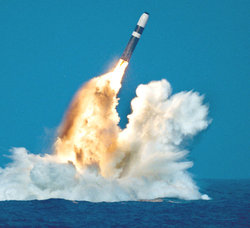Vanguard class submarine
|
|
Vanguard_class_image.jpg
The Royal Navy's Vanguard class of nuclear ballistic missile submarines (SSBNs), each armed with 16 Trident II SLBMs, includes four boats: Vanguard (S28), Victorious (S29), Vigilant (S30), and Vengeance (S31), all built by Vickers Shipbuilding and Engineering Ltd, now BAE Systems Marine (VSEL).
Vanguard, Victorious, Vigilant and Vengeance were commissioned in 1993, 1995, 1996 and 1999 respectively. At 16,000t they are twice the size of the four Resolution class Polaris SSBNs they replaced and only 3,000t lighter than the U.S. Navy Ohio class which carry 24 Trident missiles.
| Contents |
U.K. nuclear policy
The principle of operation is based on maintaining deterrent effect by always having at least one submarine at sea, and was designed for the Cold War period. One submarine is normally undergoing maintenance and the remaining two in port or on training exercises. It has been suggested that British ballistic missile submarine patrols are coordinated with those of the French [1] (http://www.thebulletin.org/article_nn.php?art_ofn=nd01norris).
Each submarine carries 16 Trident II D-5 missiles, which can each carry up to twelve warheads (i.e. a potential of 192 warheads). However, the British government announced in 1998 that each submarine would carry only 48 warheads (halving the limit specified by the previous government), which is an average of three per missile. However one or two missiles per submarine are probably armed with fewer warheads for "sub-strategic" use causing others to be armed with more.
The British-designed warheads are thought to be selectable between 0.3 kt, 5-10 kt and 100 kt; the yields obtained using either the unboosted primary, the boosted primary, or the entire "physics package". Although it owns the warheads, the United Kingdom does not actually own the missiles; instead it leased 58 missiles from the United States government and these are exchanged when requiring maintenance with missiles from the United States Navy's own pool.
History
| Name | Launched | Commissioned | Test launch 1 | Test launch 2 | Maiden patrol |
|---|---|---|---|---|---|
| HMS Vanguard (S28) | March 1992 | August 1993 | 26/05/94 | 20/06/94 | December 1994 |
| HMS Victorious (S29) | September 1993 | January 1995 | 24/07/95 | 22/08/95 | December 1995 |
| HMS Vigilant (S30) | October 1995 | November 1996 | 10/10/97 | 10/10/97 | June 1998 |
| HMS Vengeance (S31) | September 1998 | November 1999 | 21/09/00 | February 2001 |
The Trident missile agreement was reached in 1982 as a modification of the Polaris Missile Sales Agreement. At the time it was envisaged the entire project; four submarines, the missiles, new facilites at Coulport and Faslane and a 5% contribution to Trident research and development, would cost £5 billion. The option for a fifth submarine was discussed at the time.
The submarines were built in specially constructed facilites at Vickers Shipbuilding and Engineering Ltd, subsequently GEC Marine (VSEL) and BAE Systems Marine (VSEL), Barrow-in-Furness, Cumbria. The Trident II D-5 achieved an initial operational capability with the U.S. Navy in March 1990. Following launch and commissioning the vessels deployed on Demonstration and Shakedown Operations (DASOs). The major part of this was the test firing of Trident missiles at the United States' SLBM Launch Area, Eastern Test Range, Cape Canaveral, off the coast of Florida (see table above).
In the Strategic Defence Review published in July 1998, the British Government stated that once the Vanguard submarines became fully operational (the fourth and final one, Vengeance, entered service on 27 November 1999), it would "maintain a stockpile of fewer than 200 operationally available warheads" [2] (http://www.mod.uk/issues/sdr/deterrent.htm). The Stockholm International Peace Research Institute has estimated the figure as 185.
At the same time, the British Government indicated that warheads "required to provide a necessary processing margin and for technical surveillance purposes" were not included in the "fewer than 200" figure [3] (http://www.publications.parliament.uk/pa/cm199798/cmhansrd/vo980714/text/80714w19.htm#80714w19.html_spnew0). Many estimates for the total number of warheads are around 200, for instance the Natural Resources Defense Council believes that this figure is accurate to within a few tens, although the World Almanac suggests a potentially much higher value of 200-300.
General characteristics
- Displacement: 15,900 tons submerged
- Length: 149.9 meters
- Beam: 12.8 meters
- Draught: 12 meters
- Complement: 14 officers, 121 ratings
- Propulsion: PWR2 reactor
- Armament:
- 16 missile tubes capable of firing Trident II (D5) missiles
- four torpedo tubes capable of firing Spearfish torpedoes
- Sensors:
- sonar (bow, flank, active intercept, and towed arrays)
- periscopes: (attack and search)
- collision avoidance radar
External links
- The Royal Navy's official page (http://www.royal-navy.mod.uk/static/pages/177.html) on the Vanguard Class.
- Information page (http://www.fas.org/nuke/guide/uk/slbm/vanguard.htm) on the Vanguard Class.
- Opposition to Trident (http://www.tridentploughshares.org)
| Vanguard-class submarine |
|
Vanguard | Victorious | Vigilant | Vengeance |
| List of submarines of the Royal Navy List of submarine classes of the Royal Navy |

